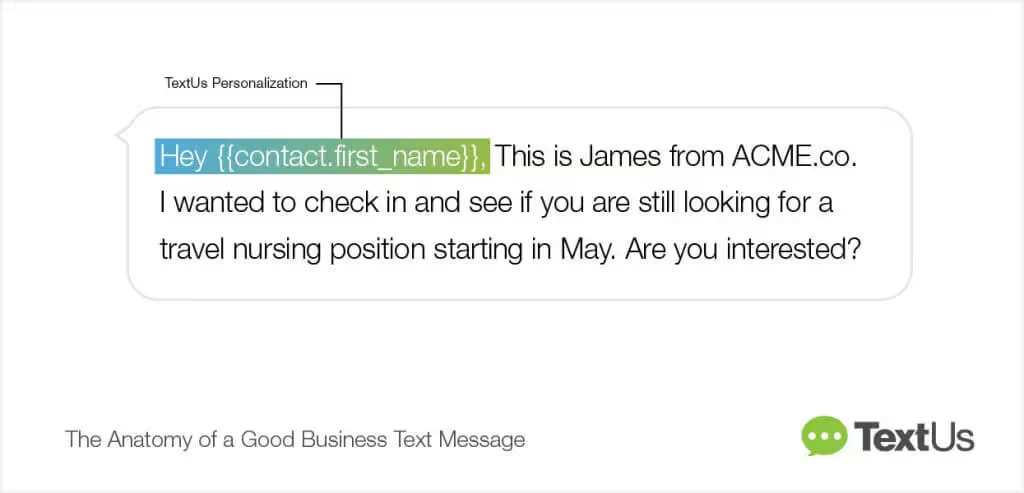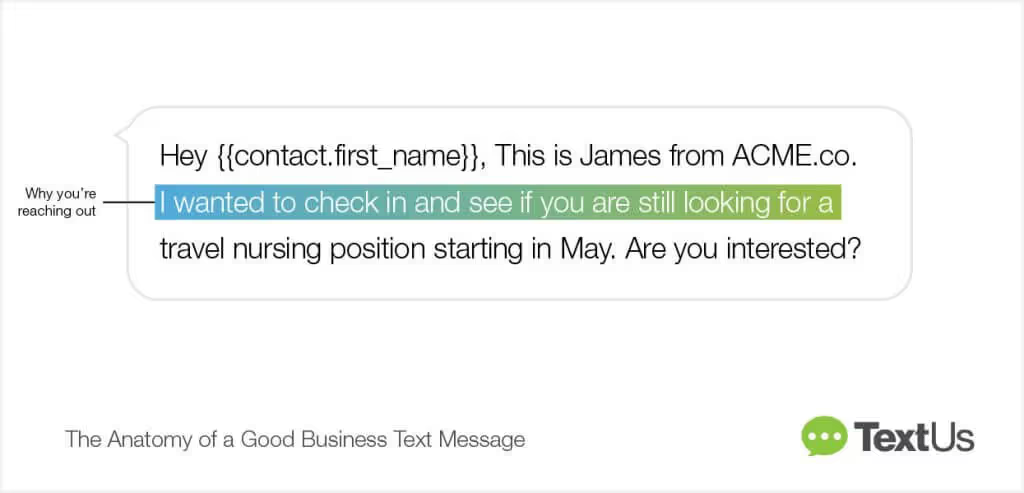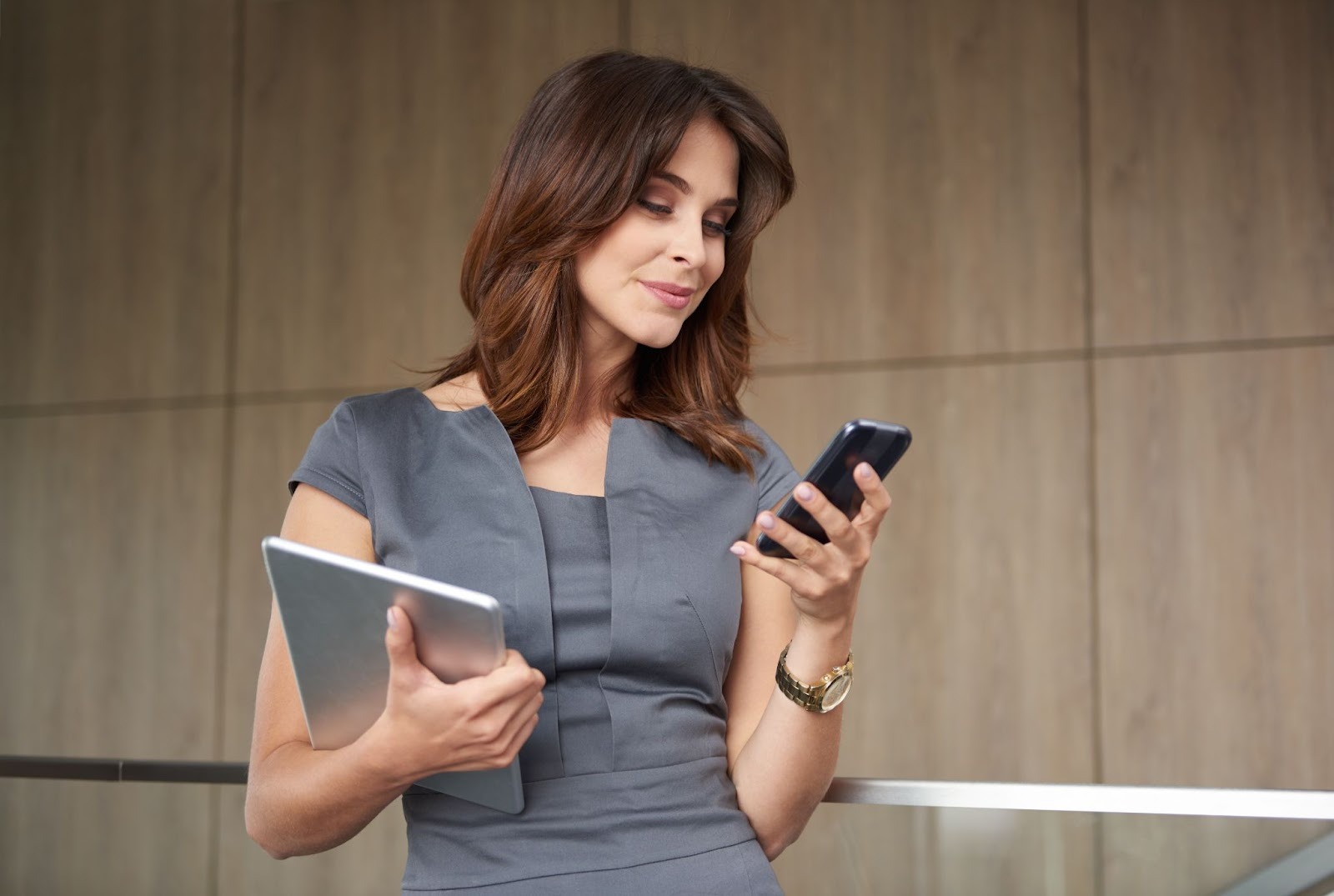The Anatomy of a Good Business Text Message
84% of consumers now opt-in for business SMS. Discover how to write texts that feel professional and drive action.
Published
January 15, 2020

Most customers now prefer brands that text—84% of consumers say they’ve opted in to at least one brand’s text messages. With open rates near 98%, texting outperforms both email and phone outreach when it comes to speed and engagement.
A professional text message builds trust, boosts replies, and reinforces your brand’s credibility. Well-written messages help you stand out from spam, drive conversions, and enhance your SMS ROI—especially in mass texting campaigns or SMS marketing strategies.
Whether you're just starting with business texting or refining your existing workflow, mastering professional texting etiquette is essential to success.
Here, we tap our experience working with customers in various industries to breakdown what makes a really good business text message.
1. Your greeting
Your greeting is the outstretched hand of your text message. It may just be two or three words, but it’s universally important. Sending a text without a greeting is the equivalent of walking into a room of strangers and launching into a conversation without saying hello.

The greeting has a few clear functions:
- Breaks the ice. Greet your contacts warmly!
- Introduces your company. Make sure your contact knows who you are and what your company does.
- Sets the tone of your outreach. Be informal without being overly familiar (go for “Hey” over “Wassup?”). It should also be professional without being stuffy (pick “Hi” over “Greetings”).
- Personalizes your messages. It should state your contact’s name if you know it.
Examples of other good greetings:
- Hi {First Name},
- Hey there —
- Hello! Casey here from TextUs,
2. Your why
When you’re writing emails, you may have a tendency to spend a little time warming your contacts up or introducing yourself before getting to the point.
With text, lengthy messages aren’t just discouraged — they’re not possible. To send a single text, you need to get your entire message under 260 characters.
So, your why comes directly after your greeting and it’s the heart of your message. It lets your contacts know as soon as possible the reason you’re reaching out to them.

Here’s why you need a good why:
- To prove you’re worth their time. Your contacts are as overwhelmed as you are — and as inundated with information that wastes their time. A solid, relevant why will hook their attention — and keep it.
- To set expectations. Give contacts a clear idea why you’re hanging out in their text inbox. Your why sets you apart from spammy texts and personal texts alike.
- To increase the likelihood of getting a response. Text is all about getting to the point – the more straightforward your messages, the more likely you are to hear back from your contacts.
Examples of other good whys:
- Just reaching out to make sure you saw the email I sent this morning about our new case study.
- Wanted to check in and see if you are still looking for a travel nursing position starting in May.
- Are you interested in attending a collaborative conference built for administrators of MFA programs?
3. Your call to action
After your why, a call to action will give your message legs. Without a call to action, your messages are more likely to go unanswered.

A good call to action will:
- Define next steps. Because your contacts are so busy, they need a clear idea of what you need from them. Don’t leave it in the subtext — ask directly what you’d like them to do.
- Provide value. A call to action is often a promise — if your contacts take the next step, they will get something that’s useful for them: info, a discount, or a resource.
- Get an answer to your questions. Asking a simple yes or no question is the call to action at its most straightforward. It can help you move a relationship along — or let you know that your contact isn’t interested.
If using links, opt for branded shortened ones. It'll convey trust and increase the likelihood the contact will tap the link
Examples other good calls to action:
- Are you still looking for a new provider?
- Are you interested in attending our conference?
- Reply and let me know when’s best for a quick demo.
- Visit this link on applying to a low-res grad program: xyz.edu/apply
State of SMS Engagement 2024
Looking to increase engagement with your candidates, prospects, and customers in 2024? Look no further! We conducted a survey paired with usage data to figure out which communication channels are most effective for which industry and size. Discover all of the tips about business communication and download our free report today!
Measuring & Optimizing Your SMS Performance
To make the most of your business texting strategy, you need to track the right performance indicators. Key SMS marketing metrics include open rates (often 98%+), response rates, and click-through rates. These numbers help you evaluate how effective your text messages are in engaging recipients and prompting action—especially when scaling recruitment or mass texting efforts.
A/B testing is one of the simplest ways to boost professional text message results. Test different subject lines, CTAs, or sending times to find what resonates. Even small tweaks in your messaging tone, length, or timing can lead to higher engagement and better ROI.
Follow this quick performance checklist:
Draft → A/B → Analyze → Iterate
Want to go deeper? Use the TextUs Campaigns dashboard to monitor mass texting results in real time. With actionable insights, you can improve every text—whether it’s part of an SMS recruitment campaign or a one-to-one professional outreach.
FAQ—How to Write a Professional Text Message
What is the ideal length for a business text?
A professional text message should stay under 160 characters to avoid splitting or added charges. Brevity encourages quick reads—90% of texts are opened within three minutes. Use concise, action-driven language. If more detail is needed, link out using a shortened, branded URL to keep the message clean and mobile-friendly.
How formal should the tone be?
Keep your tone professional but approachable. “Hi” or “Hey” feels more natural than “Dear Sir/Madam,” which may come off as cold or outdated. Studies show casual tones can improve engagement—up to 25% higher response rates. Your goal is clarity and connection, not sounding stiff or overly scripted.
Can I use emojis in professional texts?
Yes—when used strategically, emojis can humanize your message and boost engagement. Stick to one emoji per message for most professional contexts. A simple 👍 or 😊 adds tone without being distracting. Overuse can harm credibility, especially in business texting campaigns or formal recruitment outreach. Choose emojis that match your message’s tone and keep your audience in mind.
Do I need opt-in before texting prospects?
Yes. The TCPA requires businesses to get written consent before sending promotional or recruiting text messages. This can be done through a keyword reply, online form, or checkbox opt-in. Include opt-out language like “Reply STOP to unsubscribe” in every message to stay compliant and build trust with your audience. Without opt-in, your business risks fines and blocked messages.
How fast should I reply to inbound texts?
Speed matters. Responding within 5–10 minutes can increase conversion rates and improve satisfaction. In fact, 78% of consumers say fast replies influence whether they engage with a business. Use automated replies when immediate responses aren't possible. Prompt texting shows professionalism and helps keep recruiting messages or service chats on track?
What’s the best time of day to send a business text?
Late morning or early afternoon is ideal—between 10 a.m. and 2 p.m. Avoid early mornings, late evenings, or weekends unless pre-approved. According to smscomparison.com, response rates are highest when texts are sent during standard working hours, aligning with most clients’ availability and attention spans.
How often should I text a contact?
Limit outreach to 2–4 messages per week to avoid opt-outs. Consistency builds trust, but over-messaging leads to fatigue. For recruitment or mass texting campaigns, schedule messages with enough space between to keep communication helpful, not overwhelming. Always monitor engagement rates and adjust based on client or candidate behavior.
Next Steps—See Professional Texting in Action
TextUs makes professional texting simple and effective from the start. With a built-in templates library, real-time compliance guardrails, and an intuitive analytics dashboard, your team can write, send, and track messages confidently. Whether you're managing campaigns or 1-to-1 outreach, it’s easy to stay organized and on-brand.
Join thousands of professionals who trust TextUs to boost reply rates and streamline communication—our 517+ G2 ★★★★★ reviews speak for themselves. If you’re ready to learn how to write a professional text message that drives real results, book your demo and see TextUs in action today.
Continue Reading
Frequently Asked Questions
Business Texting
Built for Results
Create and convert pipeline at scale through industry leading SMS software




